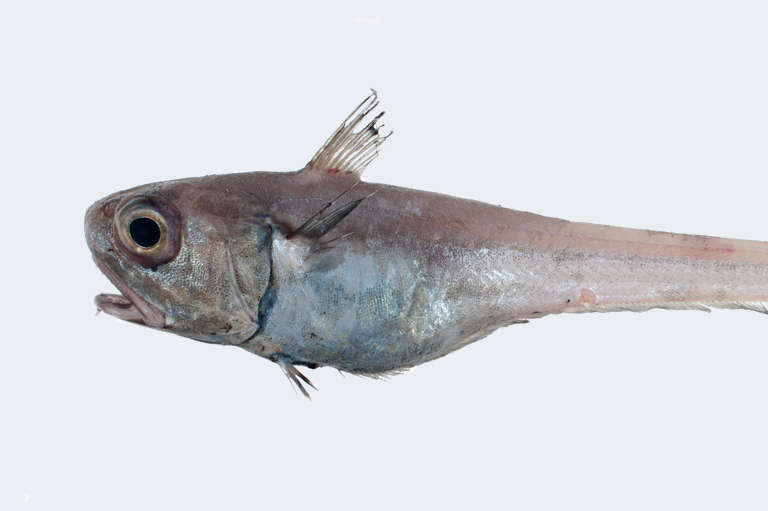Smooth Whiptail, Malacocephalus laevis (Lowe 1843)
Other Names: Smooth Whip-tail, Softhead Grenadier

A Smooth Whiptail, Malacocephalus laevis, collected during the 2003 NORFANZ Expedition to survey seamounts in the Tasman Sea. Source: Robin McPhee / NORFANZ Founding Parties. License: All rights reserved
Summary:
A greyish-brown whiptail with the lower two-thirds of the body silver, dusky to black fins and the basal part of the first dorsal fin pale. The Smooth Whiptail has a row of enlarged teeth in the upper jaw, and the large dorsal-fin spine is not serrated.
Juveniles are polka-dotted, meso- to bathypelagic, and are capable of enduring a prolonged pelagic stage.
Juveniles are polka-dotted, meso- to bathypelagic, and are capable of enduring a prolonged pelagic stage.
Cite this page as:
Bray, D.J. 2018, Malacocephalus laevis in Fishes of Australia, accessed 03 Jul 2025, https://fishesofaustralia.net.au/Home/species/4356
Smooth Whiptail, Malacocephalus laevis (Lowe 1843)
More Info
|
Distribution |
South of Marion Reef, Queensland, around southern Australia, to west of Cartier Reef in the Timor Sea; also on the Lord Howe Plateau. Elsewhere the species is circumglobal on the continental slope in tropical to subtropical waters, at depths of 200-1300 m, most commonly in about 300-700 m. |
|
Features |
Dorsal fin II, 9-13; Pectoral fin 15-21; Pelvic fin 8-9 (rarely 8); Gill rakers (first arch, outer/inner) 8-11 / 11-14; Branchiostegal rays 7; Pyloric caecae 70-100. Head compressed; snout smoothly rounded and lacking a terminal tubercle; chin barbel present; mouth rather large, subterminal; teeth in upper jaw in two rows, the outer enlarged, lower jaw teeth in one row. Snout length 26-31% HL; orbit 30-37%; interorbital width 28-33%; upper jaw 44-50%; head pores small; second spinous ray of first dorsal fin smooth. Scale rows below origin of 1st dorsal fin 16-18, below origin of 2nd dorsal 11.5-16.5; grooved lateral line complete to end of tail. A bean-shaped fossa between pelvic fin bases, an oval fossa just before anal surround. |
|
Biology |
The species has a long pelagic stage, and juveniles may reach up to 20 cm TL before settling near the bottom. |
|
Fisheries |
Although rarely taken in large quantities in Australia, the Smooth Whiptail occurs in most trawl catches within its common depth range. |
|
Species Citation |
Macrourus laevis Lowe 1843, Proc. Zool. Soc. London 11: 92. Type locality: off Madeira. |
|
Author |
Bray, D.J. 2018 |
|
Resources |
Smooth Whiptail, Malacocephalus laevis (Lowe 1843)
References
Cohen, D.M. (ed.) 1973. Fishes of the western North Atlantic. Halosuriforms, Killfishes, Squirrelfishes and other Beryciforms, Stephanoberyciforms, Grenadiers. Yale University : The Sears Foundation of Marine Research Mem. I Pt 6 698 pp.
Günther, A. 1862. Catalogue of the Fishes in the British Museum. Catalogue of the Acanthopterygii Pharyngognathi and Anacanthini in the collection of the British Museum. London : British Museum Vol. 4 534 pp. Ref at BHL
Günther, A. 1887. Report on the deep-sea fishes collected by H.M.S Challenger during the years 1873–1876. Report on the Scientific Results of the Voyage of H.M.S. Challenger 1873–1876, Zoology 22(57): 1-268 figs 1-7 pls 1-66 (Plate Vll, Fig. 62)
Iwamoto, T. 1986. Family No. 93: Macrouridae. pp. 330-341 in Smith, M.M. & Heemstra, P.C. (eds). Smith's Sea Fishes. Johannesburg : Macmillan South Africa xx + 1047 pp. 144 pls.
Iwamoto, T. 1990. Family Macrouridae. pp. 90-318 in Cohen, D.M., Inada, T., Iwamoto, T. & Scialabba, N. FAO Species Catalogue. Gadiform fishes of the world (order Gadiformes). An annotated and illustrated catalogue of cods, hakes, grenadiers and other gadiform fishes known to date. FAO Fisheries Synopsis No. 125. Rome : FAO Vol. 10 442 pp.
Iwamoto, T. 1999. Families Macrouridae, Bathylagidae, Moridae, Bregmacerotidae. pp. 1986-1998 in Carpenter, K.E. & Niem, V.H. (eds). The Living Marine Resources of the Western Central Pacific. FAO Species Identification Guide for Fisheries Purposes. Rome : FAO Vol. 3 pp. 1397-2068.
Iwamoto, T. 2015. Malacocephalus laevis. The IUCN Red List of Threatened Species 2015: e.T190093A15602990. http://dx.doi.org/10.2305/IUCN.UK.2015-4.RLTS.T190093A15602990.en. Downloaded on 28 October 2018.
Iwamoto, T. & Graham, K.J. 2001. Grenadiers (Families Bathygadidae and Macrouridae, Gadiformes, Pisces) of New South Wales, Australia. Proceedings of the California Academy of Sciences 52(21): 407-509 figs 1-114
Iwamoto, T. & McMillan, P.J. 2008. Family Macrouridae. pp. 320-347 in Gomon, M.F., Bray, D.J. & Kuiter, R.H. (eds). Fishes of Australia's Southern Coast. Sydney : Reed New Holland 928 pp.
Iwamoto, T. & Williams, A. 1999. Grenadiers (Pisces, Gadiformes) from the continental slope of western and northwestern Australia. Proceedings of the California Academy of Sciences 51(3): 105-243 figs 1-58
Last, P.R., Pogonoski, J.J., Gledhill, D.C. White, W.T. & Walker, C.J. 2014. The deepwater demersal ichthyofauna of the western Coral Sea. Zootaxa 3887 (2): 191–224
Lowe, R.T. 1843. Notices of fishes newly observed or discovered in Madeira during the years 1840, 1841 and 1842. Proceedings of the Zoological Society of London 11: 81-95 Ref at BHL
McMillan, P. 1994. Family Macrouridae. pp. 340-364 figs 304-325 in Gomon, M.F., Glover, C.J.M. & Kuiter, R.H. (eds). The Fishes of Australia's South Coast. Adelaide : State Printer 992 pp. 810 figs.
McMillan, P.J. & Iwamoto, T. 2015. Families Macrouridae, Bathygadidae, Macrouroididae, Trachyrincidae. pp. 747-838 in Roberts, C.D., Stewart, A.L. & Struthers, C.D. The Fishes of New Zealand. Wellington : Te Papa Press Vol. 3 pp. 577-1152.





